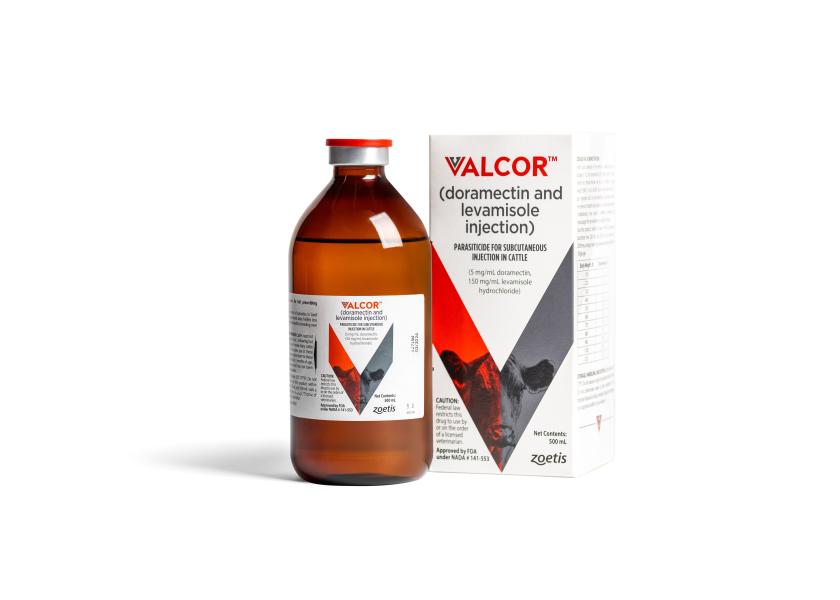Zoetis Introduces Valcor Injectable, with Doramectin and Levamisole, for Parasite Control

Zoetis announces it is introducing Valcor, the first approved dual-active endectocide available by prescription, to the beef and dairy industry. The product contains doramectin (Dectomax) and levamisole, according to Mark Alley, senior technical services veterinarian for Zoetis.
Valcor is designed to address 35 internal and external parasites – including various growth stages.
The parasite spectrum targeted for control includes adult and L4 of Haemonchus placei, Cooperia spp. (including C. oncophora) and Ostertagia ostertagi, as well as the adult version of Nematodirus helvetianus and Ostertagis ostertagi (inhibited L4).
The product is also indicated for the treatment and control of lungworms, eyeworms, grubs, mange mites and sucking lice.
Target Populations Approved For Treatment
Valcor can be used in beef cattle 2 months of age and older and in replacement dairy heifers less than 20 months of age. It is not for use in beef bulls intended for breeding over 1 year of age, dairy calves or veal calves.
It will be administered in a single, subcutaneous injection of 1 mL per 55 lb. of body weight.
Valcor will be available for purchase, starting August 1, 2023, company officials said during a virtual media conference call on Thursday.
Veterinarians were informed of the new product this past week during a similar online meeting, according to Alley.
“The information on Valcor will also be presented at the Academy of Veterinary Consultants meeting coming up next week,” he adds.
Why Injectable Imidazothiazole?
As the company evaluated active ingredients it could bring to the marketplace as a new tool to combat parasites in beef and dairy cattle, injectable imidazothiazole came to the company’s attention. Out of the 286.5 million doses of parasiticides sold in the U.S. in 2022, for use in 39 million beef and dairy cows, none were injectable imidazothiazole, Alley reports.
“That gives us a great opportunity to be able to incorporate this particular class of dewormer into our program and, hopefully, be able to get much better control than we historically have gotten with some of the other dewormers that we have available to us,” he says.
Mode Of Action
Alley says the two active ingredients in Valcor lead to parasite paralysis and death. How the two active ingredients work:
• Doramectin modulates the activity of chloride ion channels in the nervous system of nematodes and orthropods to inhibit the electrical activity of nerve cells.
• Levamisole is a nicotinic acetylcholine receptor agonist that continuously stimulates worm muscles.
In a research study with more than 1,500 head of heifers, Valcor reduced fecal egg count numbers by 99.9% compared to a leading competitor at 85%, Alley reports.
Heifers treated with Valcor gained 9.3 pounds more than the competitor-treated heifers over 56 days. “That additional weight gain adds up to more dollars per head,” he says.
IMPORTANT SAFETY INFORMATION
Do not treat cattle with Valcor within 15 days of slaughter. Not for use in female dairy cattle 20 months of age or older, including dry dairy cows; not for use in beef calves less than 2 months of age, dairy calves, and veal calves. Safety has not been evaluated in breeding bulls. Use with caution in cattle treated with cholinesterase inhibitors. This product is likely to cause injection site swelling; tissue damage (including granulomas and necrosis) may occur. These reactions have resolved without treatment. See full Prescribing Information at ValcorTough.com/pi.







